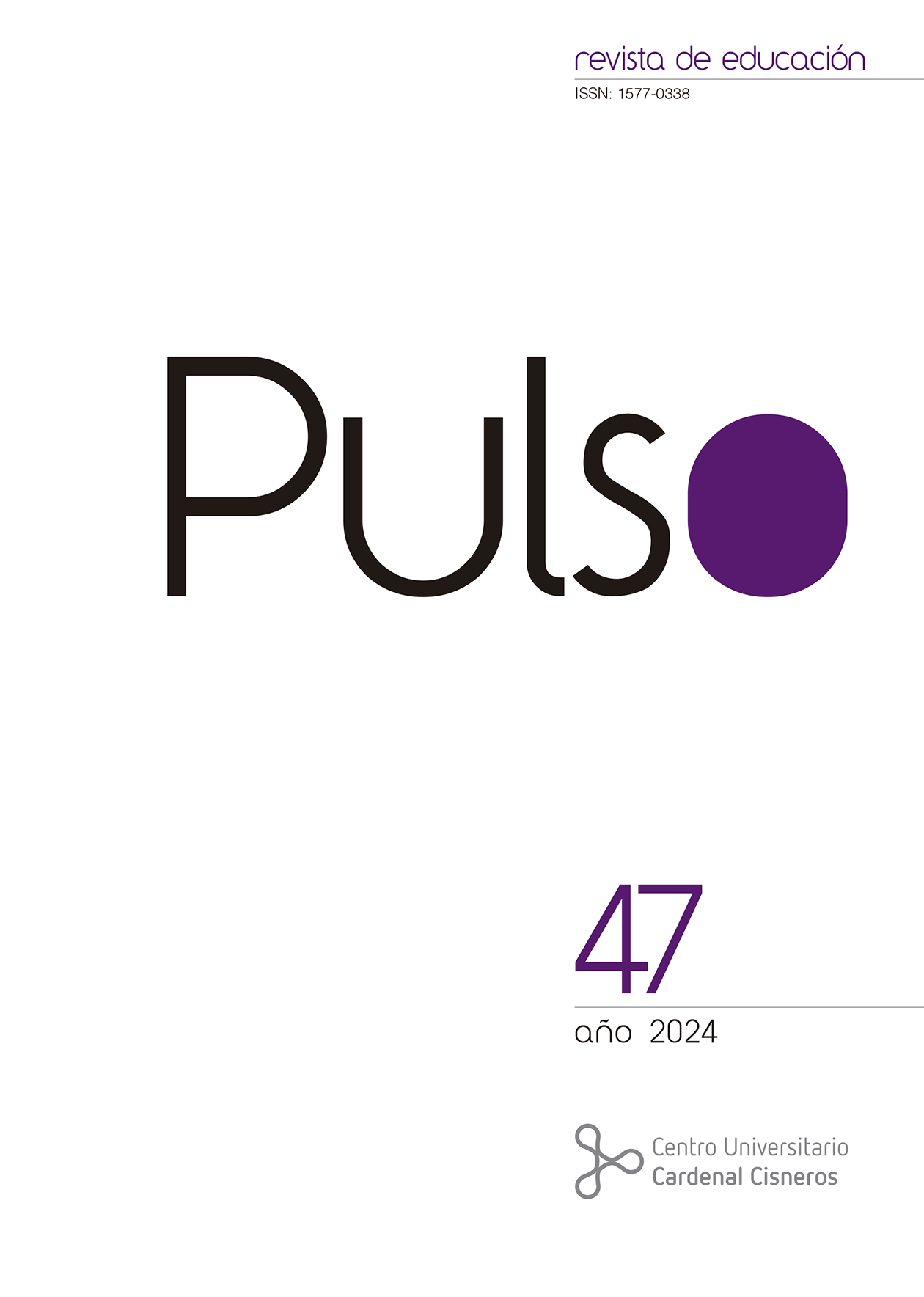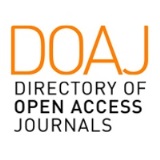Installation art in the context of Métodos Artísticos Educadores (MAES). An analysis based on experiences with students from Teacher Education Degrees
DOI:
https://doi.org/10.58265/pulso.6393Keywords:
art education, early childhood education, primary education, art installations, art methodologiesAbstract
In Artistic Teaching Methodologies (MAE) or Artistic Educational Methods (MAES), we find an ideal context for involving teacher training students in methods that articulate the contemporary nature of art and education, such as installations. These methodologies, rooted in the artistic field, promote teaching and learning through the creation and development of different artistic-educational projects. The present study is part of a Teaching Innovation Project implemented in the Infant and Primary Teaching Degrees. Its purpose is to explore the impact of Artistic Educational Methods on student teachers through the creation of installations. A detailed analysis is carried out, covering the type of installations, the experiences generated, the learning acquired, and the difficulties encountered. The results allow us to conclude that students understand the value and possibilities of working with art installations in their future teaching. At the same time, they are aware of the obstacles that can be encountered both in the conception and implementation of this type of proposal.
Downloads
References
Adams, T. E.; Ellis, C. y Stacy, H. J. (2017). Autoethnography, en Matthes, J.; Davis, S. C. y Potter, R. F. (Eds.), The International Encyclopedia of Communication Research Methods. Wiley & Sons, Inc.
Agirre, I. (2005). Teorías y prácticas en educación artística. Octaedro-eub.
Álvarez-Uria A., Garay B. y Vizcarra M. T. (2022). Las instalaciones artísticas en educación infantil: Experiencias lúdicas y performativas. Arte, Individuo y Sociedad, 34(3), 891–910. https://doi.org/10.5209/aris.76087
Anderson, l. (2006), Analytic Autoethnography, en Journal of Contemporary Ethnography, 35 (4), 373–395 https://doi.org/10.1177/0891241605280449
Apollonio, M. (2015). Spazio ad Attivazione Cinetica 6B, 1966-2015, installazione a pavimento in vinile, 5 metri. Galleria 10 A.M. ART e Marina Apollonio.
Baquero, R. (2002). Del experimento escolar a la experiencia educativa. La transmisión educativa desde una perspectiva psicológica situacional. Perfiles Educativos, 24 (97-98), 57–75.
Bishop, C. (2005) Installation Art a Critical History. Tate.
Burbules, N. (1999). El diálogo en la enseñanza. Teoría y práctica. Amorortu.
Caeiro Rodríguez, M. (2022a). Instalaciones artísticas educativas: experiencias con futuras maestras de educación infantil en torno a prácticas artísticas contemporáneas. Observar. Revista Electrónica De Didáctica De Las Artes (16), 45–66.
Caeiro Rodríguez, M. (2022b). Manos cognitivas artísticas. De las manualidades inertes en educación a la plasticidad y visualidad cognoscitiva del proceso artístico. En Grietas y provocaciones (pp.552–563). INSEA.
Cagnoni, R. (1963) (fotógrafo). Bridget Riley, Op Art British painter, with some of her works. Getty Images.
Dawe (2011). Plexus nº 9, site specific installation at Peel Gallery, 25 x 4 x 14 m.
De la Herrán, A. (2008). Metodología didáctica en Educación Secundaria: una perspectiva desde la Didáctica General. En A. De la Herrán y J. Paredes Labra (Coords.), Didáctica general: la práctica de la enseñanza en Educación Infantil, Primaria y Secundaria (pp. 134–150). McGraw-Hill España.
Delors, J. (1996). Los cuatro pilares de la Educación. La Educación encierra un Tesoro. Informe a la UNESCO de la Comisión Internacional sobre la Educación para el Siglo XXI. Ediciones UNESCO, Santillana.
Dewey, J. (2008). El Arte como experiencia. Paidós.
Díaz Barriga, F. (2003). Cognición situada y estrategias para el aprendizaje significativo. Revista Electrónica de Investigación Educativa, 5 (2).
Díaz-Obregón Cruzado, R. (2006). Arte contemporáneo y educación artística: los valores potencialmente educativos de la instalación [Tesis doctoral]. http://biblioteca.ucm.es/tesis/bba/ucm-t26912.pdf
Evertson, C. & Green, J. (1989). La observación como investigación y método. En M. Wittrock (Ed.), La investigación de la enseñanza II. Métodos cualitativos y de observación (pp. 303–421). Paidós.
Foster, H. (2001). El Artista como etnógrafo, en H. Foster (Ed.), El Retorno de lo Real. La vanguardia a finales de siglo. Akal.
Freire, P. y Passetti, E. (2018). La voz del maestro: conversaciones acerca de vivir, enseñar y transformar el mundo. Siglo XXI editores.
Giddens, A. (1994). The consequences of modernity. Stanford, CA: Stanford University Press.
Gold, R. L. (1958). Roles in Sociological Field Observations. Social Forces, 36, 217–223
Hernández, F. (2008). La investigación basada en las artes. Propuestas para repensar la investigación en educación, Educatio Siglo XXI, 26, 85–118.
Jenlink, P. M., & Austin, F. S. (2013). Situated cognition theory. The handbook of educational theories, 185–198.
Junker, B. (1960). Field Work: An Introduction of Social Sciences. University of Chicago Press.
Kandinsky, V. (1913) (Pintor). Color Study. Squares with Concentric Circles. Watercolor, gouache and crayon on paper 9.4 × 12.4” (23.8 × 31.4 cm) Munich, The Städtische Galerie im Lenbachhaus.
Kilpatrick, W. (1925). Foundations of method. Informals talks on teaching [versión Adobe Digital Editions]. Macmillan.
Knoll, M. (1997). The project method: Its vocational education origin and international development. Journal of Industrial Teacher Education, 34 (3), 59–80.
Kosuth, J. (1991). The artist as anthropologist, En G. Guercio y J. F. Lyotard (Eds.), Art after Philosophy and After (pp. 1966–1990). Colleted Writtings The MIT Press.
López-Martínez, M. D. y Moreno, L. (2019). La instalación artística como propuesta didáctica para fomentar el desarrollo social en educación infantil. En M.D. López, E.C. Mesas y E. Santos (coord.). Interacciones artísticas en espacios educativos y comunitarios (pp. 241–266). Nau Llibres.
Mackee, D. (2023). Elmer. Beascoa.
Malaguzzi, L. (2021). La educación infantil en Reggio Emilia. Octaedro.
Marín Viadel, R. (2020). ¿Cómo se escribe el pie de imagen en Investigación basada en Artes Visuales? En R. Marín Viadel, J. Roldán y M. Caeiro Rodríguez (Edts.), Aprendiendo a enseñar artes visuales. Un enfoque a/r/tográfico (pp. 220–229). Editorial Tirant Humanidades.
Marín Viadel, R. (2011). Las investigaciones en educación artística y las metodologías artísticas de investigación en educación: temas, tendencias y miradas, Educação, 34 (3), 271–285.
Martínez Cano, S. (2019). Instalaciones artísticas como metodología de aprendizaje en futuros docentes. En Tendencias y retos en la formación inicial de docentes (pp. 313–326). Universidad Pontífica de Comillas.
Martínez Pérez, D., Gavilán Izquierdo, J.M. y Toscano Cruz, M.d.l.O. (2017). Las interacciones que surgen en el trabajo por rincones en Educación Infantil. IJERI: International Journal of Educational Research and Innovation, 7, 226–244.
Mascarell Pérez, E. (2014). Pedagogía relacional. Bases teóricas y metodológicas para una educación inclusiva [Tesis doctoral]. Universidad de La Laguna.
Mesías-Lema, J. M. (2019). Educación Artística Sensible. Cartografía contemporánea para arteducadores. Editorial GRAÓ.
Mondrian, P. (1930) (Pintor). Composición en rojo, azul y amarillo. Óleo sobre tela, 59,5 cm x 59,5 cm. Museo Gemeentemuseum, La Haya (Países Bajos).
Moreno Pabón, C. (2014): Nuevos métodos en la educación artística. Experiencias docentes con MeTaEducArte (Método para talleres de educación desde el arte). Taller danzando mis emociones, el cuerpo como herramienta artística. Historia y Comunicación Social, 19, 145–159.
Munari, B. (2016). ¿Cómo nacen los objetos? Apuntes para una metodología proyectual. Editorial Gustavo Gili.
Pfister, M. (2005). El pez arcoíris. Beascoa Tres.
Quintana Forms, J. y Cisternas Chávez, A. (2018). Educación relacional. Diez claves para una pedagogía del reconocimiento. Fundación Santa María-Ediciones SM.
Read, H. (1986). Educación por el Arte. Paidós educador.
Rodríguez Gómez, G., Gil, J., & García Jiménez, E. (1999). Metodología de la investigación cualitativa. Aljibe.
Roldán Ramírez, J. y Marín Viadel, R. (2012). Metodologías artísticas de investigación en educación. Aljibe.
Rolling, J. H. (2017). Arts-Based Research in Education, in P. Leavy, (ed.) Handbook of Arts-Based Research (pp. 493–510), Guilford.
Rubio Fernández, A. (2021). Metodologías artísticas de enseñanza. Un modelo de enseñanza-aprendizaje basado en las artes visuales a través de la escultura [Tesis doctoral]. Universidad de Granada.
Rubio Fernández, A. (2015). Metodologías Artísticas de Enseñanza: Un enfoque escultórico para la educación artística. En II Congreso internacional de investigación en arte visuales (pp. 635–642). Editorial Universitat Politècnica de València.
Rubio, L y Riaño, M.E. (2019). Arte y Educación: Instalaciones en el aula de Infantil. Revista d`Innovació Docent Universitária, 11, 55–64.
Ruiz de Velasco, Á., & Abad, J. (2020). Interrelación entre el espacio y las acciones en las instalaciones de juego. Pulso. Revista de Educación, 43, 175–192.
Ruiz de Velasco, Á., y Abad, J. (2019). El lugar del símbolo: el imaginario infantil en las Instalaciones de Juego. Graó.
Ruiz de Velasco, Á., y Abad, J. (2014). Contextos de simbolización y juego. La propuesta de las instalaciones. Revista Aula de Infantil, 77, 11–28.
Ruiz de Velasco, A., Abad, J. (2011). El juego simbólico. Graó.
Sainz, F. (1961). El método de proyectos. Buenos Aires, Argentina: Losada (Edición original Madrid, España: Publicaciones de la Revista de Pedagogía, 1928).
Salido López, P. V. (2020). Metodologías activas en la formación inicial de docentes: Aprendizaje Basado en Proyectos (ABP) y Educación Artística. Profesorado. Revista de currículum y formación del profesorado, 24(2), 120–143.
Saura, A. (2012). Arteducación. Proyecto de innovación para la formación contínua con TIC en el desarrollo de la competencia cultural y artística. En Estela Bernad Monferrer y César Fernández Fernández (Coords.), Labores docentes e investigadoras en el EEES (pp. 293–312). Visión libros.
Sullivan, G. (2004). Art Practice as research Inquiryn the visual Arts. Teachers College, Columbia University.
Trigo Martínez, C. (2019). Los espacios comunes de la escuela: proyectos comunitarios a través de ArtEducación. ENSAYOS. Revista De La Facultad De Educación De Albacete, 34(1), 137–148.
Trueba Marcano, B. (2020). Espacios en armonía. Propuestas de actuación en ambientes para la infancia. Octaedro.
Valero, E.C. y Rodríguez, L. (2022). La performance, instrumento transversal de enseñanza y aprendizaje. Narración de una experiencia transformadora con alumnado de 4º de Educación Primaria. Educación artística: revista de investigación (EARI), 13, 141–151. https://dx.doi.org/10.7203/eari.13.22997
Vergara Ramírez, J. J. (2015). Aprendo porque quiero. El Aprendizaje Basado en Proyectos (ABP), paso a paso. Biblioteca Innovación EDUCATIVA. Ediciones SM.
Vialleton, A. (1969). Soto.s/t, Exposición individual “Soto”, 500 x 2919 x 2442 cm. Museo de Arte Moderno de París, París, Francia. Courtesy Archives Soto.
Yuni, J. y Urbano, C. (2005). Mapas y herramientas para conocer la escuela: investigación etnográfica e investigación-acción. Brujas.
Ziehe, J. (2011). Obra de Tomoko Sauvage, In curved water, Ice blocks, porcelain bowls, hydrophones, sound system, 388 x 360 x 428 cm 152 3/4 x 141 3/4 x 168 1/2 inches Courtesy the artist and Galerie Chantal Crousel, Paris.
Downloads
Published
How to Cite
Issue
Section
License
Copyright (c) 2024 Pulso. Revista de educación

This work is licensed under a Creative Commons Attribution-NonCommercial-NoDerivatives 4.0 International License.
This journal offers immediate open access to its content based on the idea that offering readers free access to research favours a global exchange of knowledge.
Papers are published in the electronic version of the journal under a Creative Commons License: Attribution-NonCommercial-No derivatives 4.0 International
Authors are allowed and encouraged to promote the post-print version (reviewed and accepted for publication version) of their work online before publishing them. This favours their earlier circulation and dissemination and thus a possible increase in their citation and reach among the academic community.














